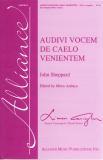Composed by John Sheppard
Edited by
Mitos Andaya
Series Editor: Simon Carrington
Voicing: SSAA a cappella
Catalog number: AMP 0631
Price: $1.60

AUDIVI VOCEM DE CAELO VENIENTEM
John Sheppard (c. 1515-1560)
Relatively little information is known about English composer John Sheppard. He served as Informator Choristarum at Magdalen College, Oxford and was a Gentleman of the Chapel Royal in the 1550s. Though he was a prolific composer of liturgical music, his works have been overshadowed by better-known English composers such as Taverner, Tallis and Byrd.
“Audivi vocem de caelo venientem” is the eighth respond for the Office of Matins on All Saints Day. This particular setting demonstrates Sheppard's mastery of polyphony and expressive imitation ý elements that are present in much of his choral writing.
EDITORIAL NOTES
The original voicing for Sheppard's setting was for two means and two tenors; however, Renaissance musicians practiced transposition regularly to make best use of the singers available on particular occasions. This setting (transposed up a perfect 5th from the original) works well for modern SSAA ensembles and can be transposed further as needed.
The slurs in the chant have been altered to clarify the melismas for today's ensembles, rather than to indicate the ligatures of the original chant.
The tenuto marks in the chant are merely indications where a slight relaxation in tempo may enhance the overall effect. Breath marks are also suggested.
PERFORMANCE NOTES
Attention should be given to the imitation between pairs of voices throughout. There are fine examples of this technique on the text clamor factus est. In this setting, centered around A, the note F is particularly expressive and should be treated as such, especially when A is in the lowest voice. Examples of this are in the first note of the soprano 1 m. 16, and the first note of the soprano 2 in m. 28. The note F should feel the pressure and the note that follows the release. These expressive devices apply to any phrase where a 6th above the lowest note (the pressure note) releases to the 5th and these are indicated in this edition by small tenuto lines over the relevant notes. Text stress is also indicated by lines under the appropriate syllables.
Slight ritardandi and a relaxation of the tempo are encouraged in the penultimate bars leading into the closing cadence of each major section.
The accidentals above the notes in measures 26, 27, 29, and 30 are editorial suggestions. If taken, the false relation between the G sharp and G natural will create a striking effect often seen and heard in early English Renaissance music. Singers of the day would have added this kind of musica ficta almost on a whim.
Mitos Andaya
TRANSLATION
Audivi vocem de caelo venientem: I heard a voice come from heaven:
Venite omnes virgines sapientissimae Come all ye most-wise virgins
Oleum recondite in vasis vestris, Store up oil in your vessels
Dum sponsus advenerit. until the Bridegroom comes.
Media nocte clamor factus est: In the middle of the night the cry was made:
Ecce sponsus venit. Behold the Bridegroom comes.
Oleum recondite in vasis vestris, Store up oil in your vessels
Dum sponsus advenerit. until the Bridegroom comes.
Click here to see a sample.
Click here to listen to a recording (MP3).



